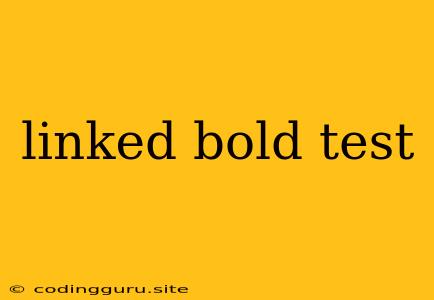Understanding and Utilizing Linked Bold Text
Have you ever come across text that is both bold and linked? This combination, known as linked bold text, presents a unique way to highlight and emphasize information while simultaneously providing access to further details. While the concept might seem simple, the implementation and utilization of linked bold text can vary depending on the platform or software you are using.
What is Linked Bold Text?
Linked bold text is a combination of two fundamental text formatting styles:
- Bold: This style makes text appear thicker and more prominent, drawing attention to specific words or phrases.
- Link: This style transforms a portion of text into a clickable element, directing users to a different web page or resource.
When these two styles are combined, you get linked bold text – a visually emphasized element that also serves as a pathway to more information.
Why use Linked Bold Text?
The use of linked bold text offers several advantages, especially when it comes to presenting information in a clear and engaging manner:
- Enhanced Clarity: Linked bold text helps to easily identify key information and highlight important aspects of a document.
- Improved User Experience: Users can quickly and effortlessly access additional information by simply clicking on the linked bold text, leading to a smoother and more interactive experience.
- Better Engagement: Linked bold text encourages users to explore further, increasing their engagement with the presented content.
How to Implement Linked Bold Text
The process of implementing linked bold text can vary depending on the platform you're using. Here are some common methods:
- HTML: In HTML, you can use the
<strong>tag for bold text and the<a>tag for links. To combine them, simply nest the<strong>tag within the<a>tag:
This is linked bold text.
- Markdown: Similar to HTML, Markdown supports both bold and links. You can use the
**tag for bold text and thesyntax for links. To combine them, simply nest the `**` tag within thesyntax:
Examples of Linked Bold Text in Action
Here are some examples of how linked bold text is used effectively in various contexts:
- Blog Posts: When discussing a specific topic, you might use linked bold text to provide readers with further information about related resources or articles.
- Wikipedia Articles: Wikipedia often employs linked bold text to direct readers to detailed pages on specific subjects or concepts.
- Educational Materials: Teachers and educators might use linked bold text to link students to supplementary materials or online exercises.
Tips for Effective Use of Linked Bold Text
To make the most of linked bold text, keep these tips in mind:
- Be Purposeful: Only use linked bold text when it provides genuine value to the user. Don't overuse it, as it can become distracting.
- Clear and Concise: Make sure the linked text itself is clear and concise, accurately reflecting the information it leads to.
- Relevant Links: Ensure that the links you use are relevant to the linked bold text and provide valuable information or resources.
Conclusion
Linked bold text is a powerful tool that can enhance clarity, improve user experience, and increase engagement. By combining the visual impact of bold text with the functionality of links, you can create a more interactive and informative experience for your readers. Remember to use linked bold text strategically, focusing on clarity and providing valuable information to your audience.
